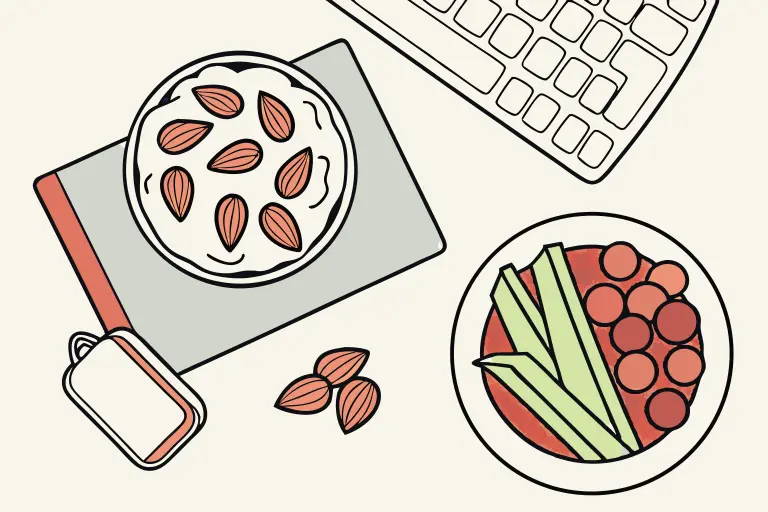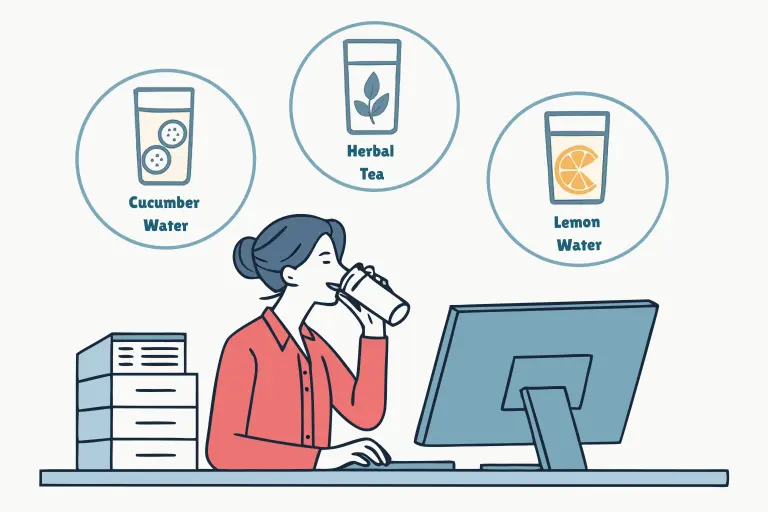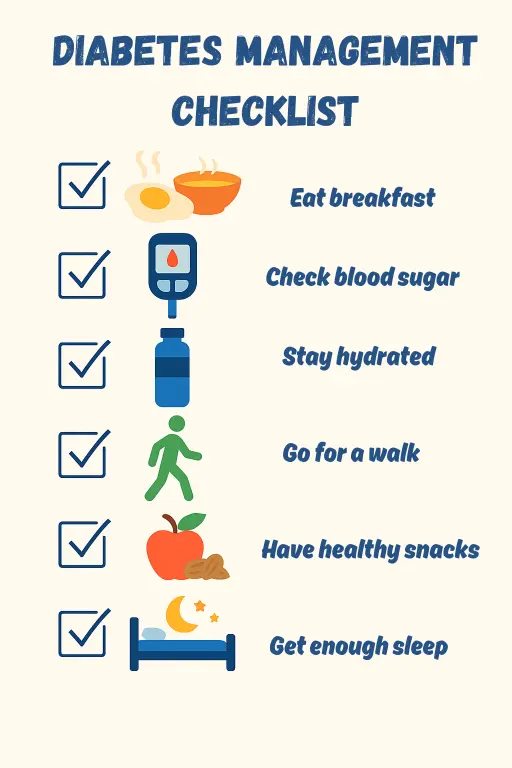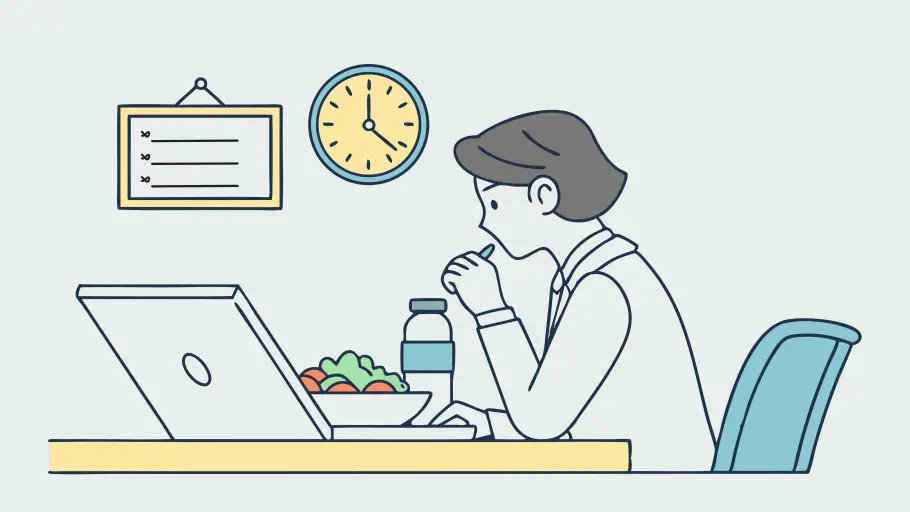Keeping your blood sugar stable while working a demanding job doesn’t have to be impossible. With the right blood sugar solution, you can stay healthy and focused throughout your entire workday.
This guide shares 12 practical ways that any busy professional can use to maintain healthy glucose levels without disrupting their career.
Why You Need a Blood Sugar Solution at Work
Today’s workplaces create serious challenges for blood sugar control. Constant stress, sitting all day, and grabbing unhealthy snacks all contribute to insulin resistance—when your body stops using insulin properly.This can lead to serious health issues like diabetes and obesity.
Work stress releases hormones that mess with your blood sugar, while sitting for hours makes it harder for your body to process glucose. Together, these create the perfect storm for developing diabetes.
The good news? Managing stress, moving more, and eating better can keep your blood sugar in check, even with a busy schedule.
Food and Diet Solutions
1. Plan Simple, Balanced Meals
The foundation of any blood sugar solution starts with smart meal planning. The diabetes plate method makes this super easy:
Fill half your plate with non-starchy vegetables:
- Leafy greens
- Bell peppers
- Broccoli
- Tomatoes
Fill one-quarter with lean protein:
- Chicken
- Fish
- Eggs
- Tofu
- Beans
- Lentils
Fill the last quarter with fiber-rich carbs:
- Quinoa
- Whole grains
- Sweet potatoes
For busy professionals, meal prepping saves time and helps you understand how your body responds to different foods. Focus on simple recipes like one-pot dishes, sheet pan meals, or slow cooker recipes.

2. Choose High-Fiber Snacks for Steady Energy
When picking office snacks, look for options with 10-20 grams of total carbs and good fiber content. High-fiber foods slow down sugar absorption and reduce insulin spikes after eating.
Best office-friendly snacks:
- 1 ounce unsalted nuts (almonds, pistachios, cashews)
- Hard-boiled eggs (6.3 grams protein, minimal carbs)
- Greek yogurt with berries
- Roasted chickpeas
- Vegetable sticks with hummus
Low-glycemic options:
- Apple slices with peanut butter
- Cheese sticks with small fruits
- Homemade trail mix (nuts with a little dried fruit)

3. Limit Caffeine and Sugar Throughout the Day
Too much caffeine can interfere with blood sugar control and increase stress hormones. Instead of sugary coffee drinks or energy drinks, choose:
- Water
- Herbal teas
- Black coffee with a small amount of milk
Replace high-sugar snacks like candy, cookies, and pastries with naturally sweet alternatives such as fresh fruit paired with protein.
4. Start Your Day with Blood Sugar-Friendly Breakfasts
A balanced breakfast sets you up for stable blood sugar all day. Overnight oats work great for busy professionals because you can make them ahead of time.
To make blood sugar-friendly overnight oats:
- Use a 1:1 ratio of oats to liquid
- Choose whole milk or unsweetened plant-based milk
- Add protein through Greek yogurt, chia seeds, or protein powder
- Include healthy fats from nuts or nut butter
- Use fresh berries instead of dried fruit or honey
Other excellent breakfast options:
- Scrambled eggs with vegetables
- Whole grain toast with avocado
- Greek yogurt parfaits with nuts and seeds
5. Pack Diabetes-Friendly Lunches That Actually Satisfy You
Creating satisfying lunches that support blood sugar control doesn’t need to be complicated.
Great lunch ideas:
- Green salad with quinoa and low-sugar dressing, plus grilled chicken or beans
- Whole-grain sandwiches loaded with vegetables and lean protein
- Low-sodium bean soups with cheese stick and sunflower seeds
- Mason jar salads with layers of greens, vegetables, protein, and whole grains
When making sandwiches, choose mustard instead of high-calorie condiments like mayonnaise.
Hydration and Smart Snacking
6. Stay Properly Hydrated for Better Glucose Control
Dehydration can make your blood glucose more concentrated and contribute to fatigue. Water should be your go-to drink since it doesn’t affect blood sugar and helps your kidneys flush out excess glucose.
Keep a large water bottle at your desk and refill it several times daily.
For variety without added sugars:
- Herbal teas
- Sparkling water with lemon
- Infused water with cucumber or mint
Avoid sugary beverages, fruit juices, and energy drinks that cause rapid blood sugar spikes.

7. Master Smart Snacking Strategies
Effective snacking requires understanding both timing and food choices. You should feel hungry for snacks about 2-3 hours after main meals. If you’re hungry sooner, your meals might need more protein, fiber, and healthy fats.
The perfect diabetes-friendly office snack should be:
- Easy to eat without heating
- Contains 10-20 grams of total carbs
- Provides fiber or protein
- Pre-portioned to prevent overeating
Excellent low-carb choices:
- 30g almonds (2g carbs, 184 calories)
- 30g hummus with sliced peppers (5g carbs, 104 calories)
- Half an avocado (1g carbs, 133 calories)
Movement and Exercise Solutions
8. Take Short Walks for Immediate Blood Sugar Benefits
Walking is one of the most effective exercises for busy professionals managing blood sugar. Studies show walking can drop blood sugar by about 1 mg/dl per minute, with some people seeing drops of 4-6 mg/dl in just 20 minutes.
The timing matters: a 15-minute walk after each meal helps regulate blood sugar and could reduce your risk of developing type 2 diabetes. Three short post-meal walks work as well as one 45-minute walk.
During your workday:
- Take short walks during breaks
- Use stairs instead of elevators
- Schedule walking meetings when possible
Even light activity every 30 minutes provides blood glucose benefits for adults with type 2 diabetes.

9. Do Simple Desk Stretches and Movement Breaks
Sitting too long should be interrupted with light activity every 30 minutes. Simple desk stretches combat stiffness and improve circulation.
Try these throughout your workday:
- Seated neck rotations
- Shoulder rolls
- Wrist flexions
- Standing and light movements
Consider simple bodyweight exercises like desk push-ups, seated leg extensions, or standing calf raises. These activities help muscles use glucose more effectively.
Standing for one hour during the workday increased productivity for 66% of workers, while 71% felt more focused and 87% reported feeling more energized.
10. Try Standing Meetings and Active Workspaces
Standing meetings offer multiple benefits for blood sugar management. Standing boosts alertness and concentration, and without the comfort of sitting, people stay more present and engaged.
Standing naturally engages your back, shoulder, and abdominal muscles, promoting proper spine alignment. The average employee spends around 5.5 hours sitting at their desk daily.
Use standing meetings for:
- Brief check-ins
- Brainstorming sessions
- Daily team updates
- One-on-one discussions
Stress and Sleep Management
11. Practice Stress Relief Throughout Your Workday
Chronic stress significantly impacts blood sugar control. Constant stress hormones like cortisol and adrenaline directly affect your ability to manage weight, handle cravings, and prevent diabetes.
Stress reduction techniques for work:
- Deep breathing exercises
- Brief meditation sessions
- Mindfulness practices
- Short relaxation breaks between meetings
Consider using apps that remind you to pause and breathe deeply throughout the day.
Quality sleep is equally important. Poor sleep increases stress hormones and negatively impacts glucose metabolism. Aim for 7-9 hours of sleep per night and maintain consistent sleep and wake times, even on weekends. Understanding primal sleep patterns and using sleeping music for deep sleep can improve your rest quality.
Tracking and Monitoring
12. Track Your Progress Consistently
A successful blood sugar solution includes regular self-awareness. Tracking your blood glucose—whether through a simple logbook or mobile app—helps you understand how your body reacts to food, stress, and activity.
You don’t need fancy devices. Just regularly writing down your readings, energy levels, meals, and movement can reveal useful patterns over time.
Consistent tracking helps you:
- Spot trends in your glucose response to certain foods
- Understand how stress or poor sleep affects your blood sugar
- Make smarter daily choices aligned with your personal blood sugar solution
Your Complete Daily Action Plan
Sample Daily Checklist
Morning Routine:
- Check fasting blood glucose upon waking
- Eat balanced breakfast with protein, fiber, and complex carbs
- Pack healthy snacks and lunch
- Take medications as prescribed
Workday Management:
- Test blood glucose before lunch
- Take 5-minute movement breaks every 30 minutes
- Stay hydrated with water
- Choose diabetes-friendly snacks when hungry
- Practice stress-reduction during breaks
Evening Routine:
- Check blood glucose 2 hours after dinner
- Record daily readings in monitoring log
- Prepare tomorrow’s meals and snacks
- Practice relaxation before bed
- Aim for 7-9 hours of quality sleep
Understanding blood sugar and energy levels helps you identify patterns and optimize your routine. If you’re experiencing afternoon energy crashes, learn how to beat afternoon fatigue through better blood sugar management.

Making Your Blood Sugar Solution Work Long-Term
Managing blood sugar at work takes commitment and planning, but this blood sugar solution gives you everything you need to stay healthy without hurting your productivity. Remember: consistency beats perfection. Small daily changes work better than occasional big efforts.
Focus on building simple habits around meal planning, regular monitoring, movement breaks, and stress management. Your workplace can actually help your diabetes management when you communicate clearly with your boss and coworkers. Work with your healthcare team to make sure your strategies fit your treatment plan.
If you’re dealing with ongoing fatigue or chronic pain and fatigue, these might be connected to blood sugar issues. Understanding foods that cause fatigue and adding foods that naturally increase energy can help your overall health. Use these strategies consistently and work with your healthcare team to successfully manage your blood sugar while excelling at work.








